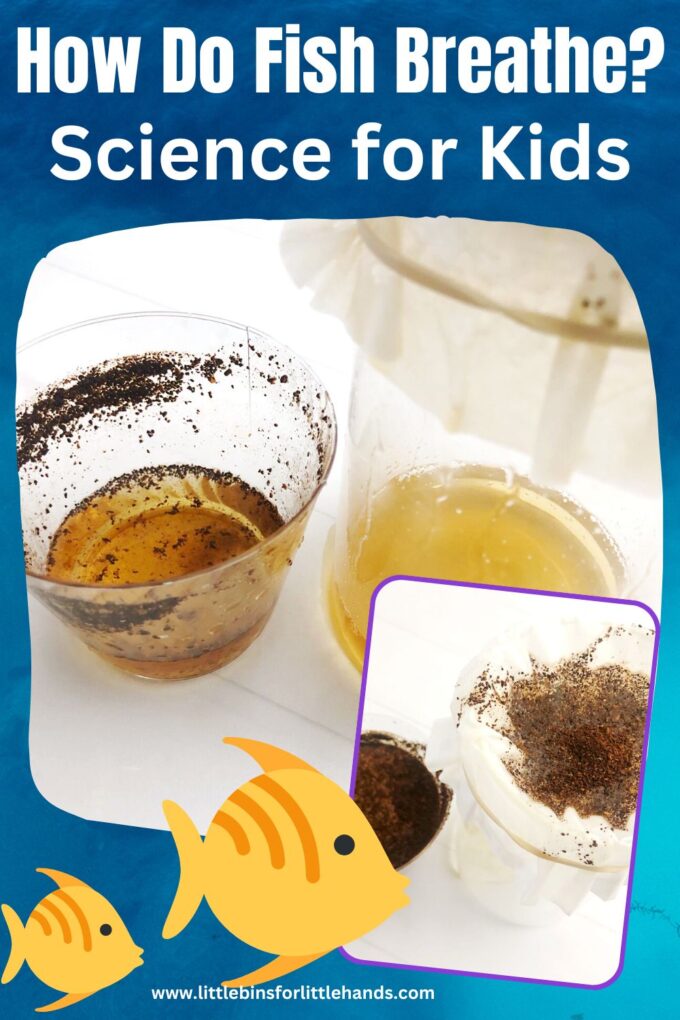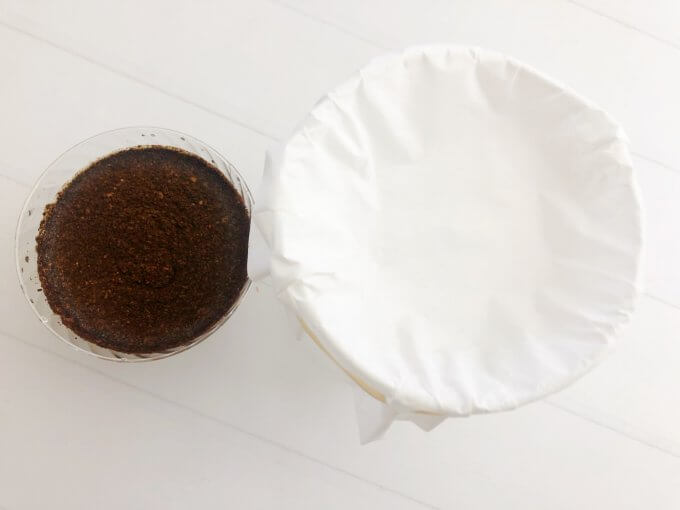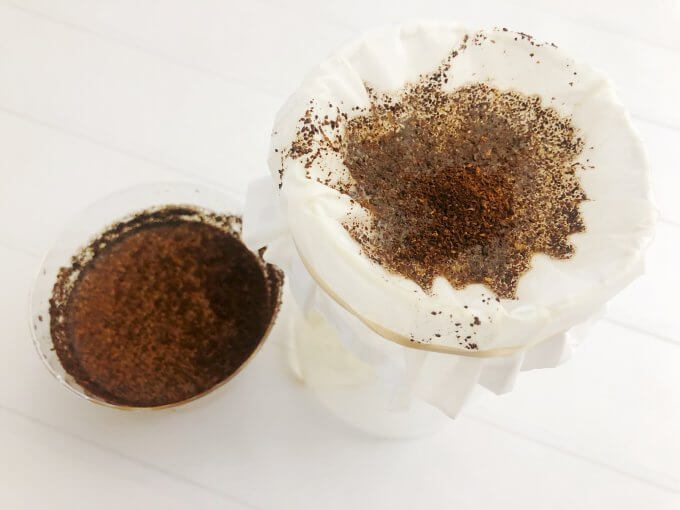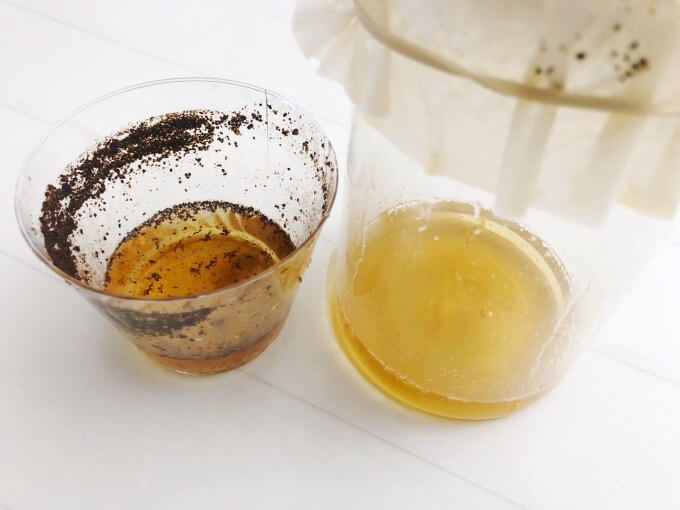They’re fun to look at in an aquarium or to try to catch in a lake, but did you know that fish breathe? But how can you see this in action without putting your head underwater? Here is a simple science activity to explore how fish breathe underwater. Set it up with simple materials at home or in the classroom! We love ocean science activities here!

Explore Science with Kids
Our science activities and experiments are designed with you, the parent or teacher, in mind! Easy to set up and quick to do, most activities take only 15 to 30 minutes to complete and are hands-on fun! Plus, our supplies lists usually contain only free or cheap materials you can source from home!
Demonstrating How Fish Breathe Underwater
A simple way to explain how fish gills work is with a coffee filter and some coffee grounds mixed in water.
The coffee filter represents the gills, and the coffee grounds represent the oxygen that the fish needs. Like the coffee filter can filter the water from the coffee grounds, the gills collect oxygen to send to the fish’s cells. A fish takes water in through its mouth and moves it through the gill passages, where the oxygen can be dissolved and pushed into the blood.
This simple ocean science activity works well, combined with lots of discussions. Get kids thinking by asking questions about how they think fish can breathe underwater and extend it to what they might already know about how fish breathe.
How Do Fish Breathe Science Activity
Let’s get right to learning about how do fish breathe. Prepare to see this big idea made understandable for young learners in your kitchen or classroom.
Supplies:
- Clear glass jar
- Cup
- Water
- Coffee filter
- Coffee grounds
- Rubber band
Instructions:
STEP 1: Fill a cup with water and mix in a tablespoon of coffee grounds. Discuss how the coffee mixture is like water in the ocean.
STEP 2: Place a coffee filter over the top of your glass jar with a rubber band around the top holding it on.
The coffee filter is like the gills on a fish.

STEP 3: Pour the coffee and water mixture slowly on to the top of the jar over the coffee filter.

STEP 4: Watch the water filter through the coffee filter.
Discuss what has been left behind in the coffee filter. Similarly, what do fish gills filter from the water? Where does the oxygen go?

Free Printable Ocean Mini Pack:
Grab a free printable ocean theme mini pack with STEM challenges, a project idea list for an ocean theme unit, and sea creatures coloring pages!
Do Fish Have Lungs?
Do fish have lungs? No, fish have gills instead of lungs as we do because human lungs need to be dry to work properly. Learn more about lungs with our lung model!
While fish require less energy and thus less oxygen to live than humans or other mammals, they still need some oxygen. Their water sources need sufficient oxygen levels to provide the necessary amounts. Low oxygen levels in the water can be dangerous for fish. Because they can’t take oxygen in from the air like we do, they get their oxygen from the water.
What are Gills?
Gills are feathery organs made of thin tissues filled with blood vessels that help to move oxygen out of the water and into the fish’s bloodstream while also removing carbon dioxide.
But how does that happen? Fish breathe underwater by swallowing water, as opposed to breathing air. The water goes in the mouth of the fish and out its gills. Gills are made of very thin tissue, which acts like a filter to remove oxygen from the water and release carbon dioxide.
Water moves through the fish’s gills, a type of frilly, large organ filled with tons of tiny blood vessels. As it does this, the gills pull oxygen out of the water and into the blood to take it to all the cells in the fish’s body.
This process of oxygen moving through the tiny holes in the membrane of the gills is called osmosis. Large molecules can not fit through the membranes, but oxygen molecules can! Instead of gills, the human lungs take oxygen out of the air we breathe and transfer it to the bloodstream to be transported throughout the body.
Why Can’t Fish Breathe Out Of Water?
Another interesting question is why fish can’t breathe out of water. Certainly, there’s still plenty of oxygen for them, right?
Unfortunately, fish can breathe underwater but not on land because their gills collapse out of water. The gills are made of thin tissues that need the flow of water for them to function. If they collapse, they can’t function properly to pull in the oxygen they need to circulate it through their system.
Although we can get oxygen from the air we breathe, the air in our lungs is very moist, making it easier to exchange oxygen and carbon dioxide.
Did you know that hermit crabs also use gills even though they can come out of the water too? However, they can only do this in humid conditions where the gills can pull the moisture from the air!
Explore More Ocean Animals
Each activity below uses a fun and easy hands-on craft or science activity to introduce kids to an ocean animal.
- Glow In The Dark Jellyfish Craft
- Salt Dough Starfish
- How Do Sharks Float
- Shark Week Activities
- How Do Whales Keep Warm
- How Do Squid Swim
- All About Narwhals
- Black Glue Jelly Fish Art



Printable Ocean Activities Pack
If you want to have all of your printable ocean activities in one convenient place, plus exclusive worksheets with an ocean theme, our 100+ page Ocean STEM Project Pack is what you need!
Check out The Complete Ocean Science and STEM Pack in our SHOP!









One Comment
Comments are closed.